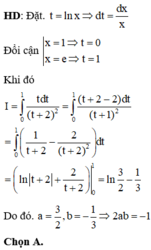Cho I = ∫ 1 e ln x x ln x + 2 2 d x có kết quả dạng I = ln a + b với a > 0 , b ∈ ℚ . Khẳng định nào sau đây đúng?
A. 2ab = -1
B. 2ab = 1
C. - b + ln 3 2 a = - 1 3
D. b + ln 3 2 a = 1 3
Hãy nhập câu hỏi của bạn vào đây, nếu là tài khoản VIP, bạn sẽ được ưu tiên trả lời.



`a)TXĐ:R\\{1;1/3}`
`y'=[-4(6x-4)]/[(3x^2-4x+1)^5]`
`b)TXĐ:R`
`y'=2x. 3^[x^2-1] ln 3-e^[-x+1]`
`c)TXĐ: (4;+oo)`
`y'=[2x-4]/[x^2-4x]+2/[(2x-1).ln 3]`
`d)TXĐ:(0;+oo)`
`y'=ln x+2/[(x+1)^2].2^[[x-1]/[x+1]].ln 2`
`e)TXĐ:(-oo;-1)uu(1;+oo)`
`y'=-7x^[-8]-[2x]/[x^2-1]`
Lời giải:
a.
$y'=-4(3x^2-4x+1)^{-5}(3x^2-4x+1)'$
$=-4(3x^2-4x+1)^{-5}(6x-4)$
$=-8(3x-2)(3x^2-4x+1)^{-5}$
b.
$y'=(3^{x^2-1})'+(e^{-x+1})'$
$=(x^2-1)'3^{x^2-1}\ln 3 + (-x+1)'e^{-x+1}$
$=2x.3^{x^2-1}.\ln 3 -e^{-x+1}$
c.
$y'=\frac{(x^2-4x)'}{x^2-4x}+\frac{(2x-1)'}{(2x-1)\ln 3}$
$=\frac{2x-4}{x^2-4x}+\frac{2}{(2x-1)\ln 3}$
d.
\(y'=(x\ln x)'+(2^{\frac{x-1}{x+1}})'=x(\ln x)'+x'\ln x+(\frac{x-1}{x+1})'.2^{\frac{x-1}{x+1}}\ln 2\)
\(=x.\frac{1}{x}+\ln x+\frac{2}{(x+1)^2}.2^{\frac{x-1}{x+1}}\ln 2\\ =1+\ln x+\frac{2^{\frac{2x}{x+1}}\ln 2}{(x+1)^2}\)
e.
\(y'=-7x^{-8}-\frac{(x^2-1)'}{x^2-1}=-7x^{-8}-\frac{2x}{x^2-1}\)

a) \(\int\dfrac{2dx}{x^2-5x}=\int\left(\dfrac{-2}{5x}+\dfrac{2}{5\left(x-5\right)}\right)dx=-\dfrac{2}{5}ln\left|x\right|+\dfrac{2}{5}ln\left|x-5\right|+C\)
\(\Rightarrow A=-\dfrac{2}{5};B=\dfrac{2}{5}\Rightarrow2A-3B=-2\)
b) \(\int\dfrac{x^3-1}{x+1}dx=\int\dfrac{x^3+1-2}{x+1}dx=\int\left(x^2-x+1-\dfrac{2}{x+1}\right)dx=\dfrac{1}{3}x^3-\dfrac{1}{2}x^2+x-2ln\left|x+1\right|+C\)
\(\Rightarrow A=\dfrac{1}{3};B=\dfrac{1}{2};E=-2\Rightarrow A-B+E=-\dfrac{13}{6}\)

\(a,y'=8x^3-9x^2+10x\\ \Rightarrow y''=24x^2-18x+10\\ b,y'=\dfrac{2}{\left(3-x\right)^2}\\ \Rightarrow y''=\dfrac{4}{\left(3-x\right)^3}\)
\(c,y'=2cos2xcosx-sin2xsinx\\ \Rightarrow y''=-5sin\left(2x\right)cos\left(x\right)-4cos\left(2x\right)sin\left(x\right)\\ d,y'=-2e^{-2x+3}\\ \Rightarrow y''=4e^{-2x+3}\)

\(\begin{array}{l}f'\left( {{x_0}} \right) = \mathop {\lim }\limits_{x \to {x_0}} \frac{{f(x) - f\left( {{x_0}} \right)}}{{x - {x_0}}} = \mathop {\lim }\limits_{x \to {x_0}} \frac{{\ln x - \ln {x_0}}}{{x - {x_0}}} = \mathop {\lim }\limits_{x \to {x_0}} \frac{{\ln \frac{x}{{{x_0}}}}}{{x - {x_0}}} = \mathop {\lim }\limits_{x \to {x_0}} \frac{{\frac{{\ln \frac{x}{{{x_0}}}}}{{\ln e}}}}{{x - {x_0}}} = \frac{1}{{\ln e}}.\mathop {\lim }\limits_{x \to {x_0}} \frac{{\ln \frac{x}{{{x_0}}}}}{{x - {x_0}}}\\ = \frac{1}{{\ln e}}\mathop {\lim }\limits_{x \to {x_0}} \frac{{\ln \left( {1 + \frac{x}{{{x_0}}} - 1} \right)}}{{x - {x_0}}} = \frac{1}{{\ln e}}\mathop {\lim }\limits_{x \to {x_0}} \frac{{\frac{x}{{{x_0}}} - 1}}{{x - {x_0}}} = \frac{1}{{\ln e}}.\mathop {\lim }\limits_{u \to 0} \frac{{\frac{{x - {x_0}}}{{{x_0}}}}}{{x - {x_0}}} = \frac{1}{{{x_0}\ln e}}\\ \Rightarrow \left( {\ln x} \right)' = \frac{1}{{x\ln e}} = \frac{1}{x}\end{array}\)

\(a,A=ln\left(\dfrac{x}{x-1}\right)+ln\left(\dfrac{x+1}{x}\right)-ln\left(x^2-1\right)\\ =ln\left(\dfrac{x}{x-1}\cdot\dfrac{x+1}{x}\right)-ln\left(x^2-1\right)\\ =ln\left(\dfrac{x+1}{x-1}\right)-ln\left(x^2-1\right)\\ =ln\left(\dfrac{x+1}{x-1}\cdot\dfrac{1}{x^2-1}\right)\\ =ln\left[\dfrac{1}{\left(x-1\right)^2}\right]\\ =2ln\left(\dfrac{1}{x-1}\right)\)
\(b,21log_3\sqrt[3]{x}+log_3\left(9x^2\right)-log_3\left(9\right)\\ =7log_3\left(x\right)+log_3x^2+log_39-log_39\\ =7log_3x+2log_3x\\ =9log_3x\)

a)
\(\begin{array}{c}A = {\log _{\frac{1}{3}}}5 + 2{\log _9}25 - {\log _{\sqrt 3 }}\frac{1}{5} = {\log _{{3^{ - 1}}}}5 + 2{\log _{{3^2}}}{5^2} - {\log _{{3^{\frac{1}{2}}}}}{5^{ - 1}}\\ = - {\log _3}5 + 2{\log _3}5 + 2{\log _3}5 = 3{\log _3}5\end{array}\)
b) \(B = {\log _a}{M^2} + {\log _{{a^2}}}{M^4} = 2{\log _a}M + \frac{1}{2}.4{\log _a}M = 4{\log _a}M\)

a) Điều kiện: \(\left\{{}\begin{matrix}4x+2>0\\x-1>0\\x>0\end{matrix}\right.\)
Hay là: \(x>1\)
Khi đó biến đổi pương trình như sau:
\(\ln\dfrac{4x+2}{x-1}=\ln x\)
\(\Leftrightarrow\dfrac{4x+2}{x-1}=x\)
\(\Leftrightarrow4x+2=x\left(x-1\right)\)
\(\Leftrightarrow x^2-5x-2=0\)
\(\Leftrightarrow\left[{}\begin{matrix}x_1=\dfrac{5+\sqrt{33}}{2}\\x_2=\dfrac{5-\sqrt{33}}{2}\left(loại\right)\end{matrix}\right.\)
Vậy nghiệm của phương trình là: \(x=\dfrac{5+\sqrt{33}}{2}\)
b) Điều kiện: \(\left\{{}\begin{matrix}3x+1>0\\x>0\end{matrix}\right.\)
Hay là: \(x>0\)
Biến đổi phương trình như sau:
\(\log_2\left(3x+1\right)\log_3x-2\log_2\left(3x+1\right)=0\)
\(\Leftrightarrow\log_2\left(3x+1\right)\left(\log_3x-2\right)=0\)
\(\Leftrightarrow\left[{}\begin{matrix}\log_2\left(3x+1\right)=0\\\log_3x=2\end{matrix}\right.\)
\(\Leftrightarrow\left[{}\begin{matrix}3x+1=2^0\\x=3^2\end{matrix}\right.\)
\(\Leftrightarrow\left[{}\begin{matrix}x=0\left(loại\right)\\x=9\end{matrix}\right.\)
Vậy nghiệm là x = 9.